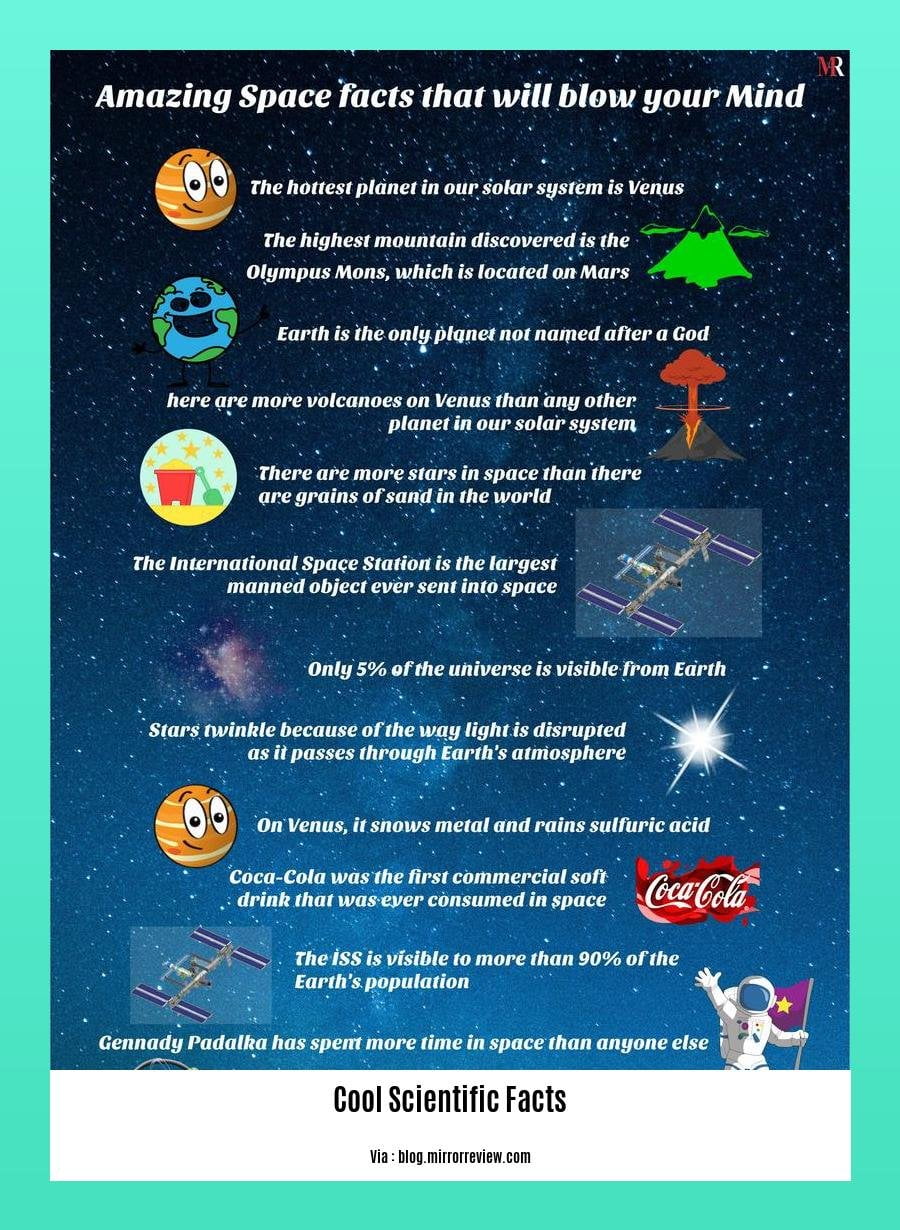Embark on an extraordinary voyage of discovery with “Unveiling the Cosmos: A Journey into Cool Scientific Facts.” This captivating exploration uncovers the wonders of our natural world, encompassing fascinating scientific phenomena that ignite curiosity and expand our understanding of the universe. From mind-bending facts about space to the intricate workings of the human body, this odyssey promises to enthrall students and ignite their passion for scientific exploration.
Key Takeaways:
Donated bodies play a vital role in medical research, education, and organ transplantation.
Marie Curie achieved the remarkable feat of winning Nobel Prizes in both Physics and Chemistry.
Despite their appearance, banana peels are surprisingly slippery due to their lack of friction.
The human body is home to an astonishing number of bacteria, contributing to our health and well-being.
The human eye possesses an incredible 576-megapixel resolution, allowing us to perceive intricate details in our surroundings.
Laika, a courageous Soviet space dog, paved the way as the first animal to journey into space aboard Sputnik 2.
Among all prime numbers, only 2 stands out as the lone even number, making it a mathematical anomaly.
Feldspar reigns as the most abundant mineral on Earth’s crust, contributing to the planet’s geological makeup.
Cool Scientific Facts


Embark on a captivating journey through the cosmos, unraveling the mysteries of the universe with our selection of intriguing scientific facts. These mind-bending revelations will ignite your curiosity and challenge your perceptions of the world around you.
Unveiling the Secrets of the Universe
- Freeze-Dried Astronauts?
Believe it or not, freeze-drying is an innovative technique being explored for preserving astronauts during long space missions. By removing 95% of their body’s water content, scientists hope to reduce the resources required for space travel.
The Unique Properties of Helium:
Helium, the second lightest element, possesses some peculiar characteristics. It has the lowest boiling point among all elements and can cause your voice to sound squeaky when inhaled.
The Sun’s Scorching Surface:
- The sun’s surface temperature is an astonishing 9,941 degrees Fahrenheit (5,505 degrees Celsius), making it hotter than the flames of a blowtorch.
Exploring the Human Body
- Trillions of Tenants Within:
Our bodies are home to an astounding number of tenants – approximately 40 trillion bacteria. These tiny organisms play a crucial role in digestion, immunity, and overall health.
The Eye’s Incredible Resolution:
- The human eye boasts an impressive resolution, capable of perceiving intricate details equivalent to a 576-megapixel camera.
Mind-Boggling Phenomena
- The Mystery of Dark Matter:
Scientists have discovered the existence of dark matter, a mysterious substance that comprises 85% of the universe’s matter. Despite its prevalence, dark matter remains elusive and is yet to be fully understood.
The Expanding Universe:
- The universe is continuously expanding at an accelerating rate, driven by a mysterious force known as dark energy. This expansion poses intriguing questions about the ultimate fate of our cosmos.
Mind-Bending Facts
- The Icy Cold of Space:
The temperature of outer space is staggeringly low, plummeting to an average of -455 degrees Fahrenheit (-270 degrees Celsius), making it considerably colder than the coldest recorded temperature on Earth.
The Sun’s Energy Output:
The sun emits an enormous amount of energy, radiating approximately 3.846 x 10^26 watts of power. This energy output is equivalent to 100 billion hydrogen bombs exploding every second.
A Supernova’s Brilliance:
When a massive star undergoes a supernova explosion, it can outshine an entire galaxy for a brief period, radiating with the luminosity of billions of suns.
The Age of the Universe:
The universe is estimated to be around 13.8 billion years old, a vast expanse of time that dwarfs human history.
The Origin of Gold:
- Gold, a precious metal, is forged in the heart of stars through a process known as nucleosynthesis. These stellar furnaces fuse elements, creating gold and other heavy elements that eventually find their way to planets.
Did you know that forensic science goes beyond TV dramas? Learn facts about forensic science that’ll blow your mind and make you appreciate the complexity of this field.
Have you heard of the devastating bushfires that have ravaged Australia? Discover 10 facts about Australian bushfires that will shed light on the severity of these natural disasters and the urgent need for action to protect our environment.
Cool Scientific Facts About Space
Have you ever gazed up at the night sky and wondered about the vastness of space? From black holes to distant galaxies, the universe is full of fascinating phenomena that can spark our curiosity and imagination. Let’s embark on a journey to discover some cool scientific facts about space:
The Sun’s Energy
Our Sun, the center of our solar system, is a hot and powerful ball of glowing gases. Did you know that it releases an enormous amount of energy every second? In fact, the Sun’s energy output is so immense that it travels 93 million miles to reach Earth in just 8 minutes!
Black Holes: A Cosmic Mystery
Black holes are one of the most mysterious objects in the universe. They are regions of spacetime where gravity is so strong that nothing, not even light, can escape. If you were to venture too close to a black hole, you would be stretched and squeezed into a thin strand of matter, a process known as “spaghettification.”
The Milky Way’s Size
Our galaxy, the Milky Way, is a vast collection of stars, gas, and dust. It’s so large that it would take light 100,000 years to travel from one end to the other! And guess what? There are an estimated 100 billion to 400 billion stars within our Milky Way galaxy alone.
Life Beyond Earth
The search for extraterrestrial life is one of the most captivating questions in science. While we haven’t found any definitive evidence yet, there are many planets and moons in our solar system and beyond that could potentially support life. Could there be microbes thriving in the subsurface oceans of Jupiter’s moon Europa, or perhaps life forms adapted to the extreme conditions on Mars? Time will tell.
Key Takeaways:
- The Sun’s energy reaches Earth in just 8 minutes, traveling 93 million miles.
- Black holes possess such strong gravity that nothing, including light, can escape their grasp.
- The Milky Way, our home galaxy, is a gigantic collection of stars, gas, and dust, spanning 100,000 light-years in diameter.
- The quest for extraterrestrial life continues, with potential habitats like Europa and Mars intriguing scientists.
Sources:
– Space Facts – 50 Things You Probably Didn’t Know – The Planets
– 103 Super Cool Facts About Space – Easy Family Fun- Games, Trivia, Activities
FAQ
Q1: What is the significance of Marie Curie’s Nobel Prize achievement?
A1: Marie Curie’s unique distinction lies in her being the only person to receive the Nobel Prize in two different scientific fields, Physics and Chemistry, showcasing her multifaceted contributions to science.
Q2: Why are banana peels slippery?
A2: Banana peels possess almost no friction, making them slippery when stepped on. This property is caused by the waxy coating on the peel, which reduces its adherence to surfaces.
Q3: What is the composition of the human body?
A3: More than half of the human body is composed of trillions of bacteria, contributing significantly to overall health and well-being. These microbes play crucial roles in various bodily functions, including digestion, immunity, and metabolism.
Q4: What is the resolution of the human eye?
A4: The human eye boasts an impressive 576-megapixel resolution, enabling us to perceive intricate details and patterns in our surroundings. This remarkable resolution allows us to navigate the world and appreciate its complexities.
Q5: How far back can we trace the age of our solar system?
A5: Our solar system holds an age of approximately 4.571 billion years, reflecting the vastness of cosmic time and the evolution of our planetary system over millennia.
- Mastering Leader in Spanish: The Complete Guide - April 19, 2025
- Uncovering Surprising Parallels: England Size Compared to US States - April 19, 2025
- Old Mexico Map: Border Shifts 1821-1857 - April 19, 2025
















